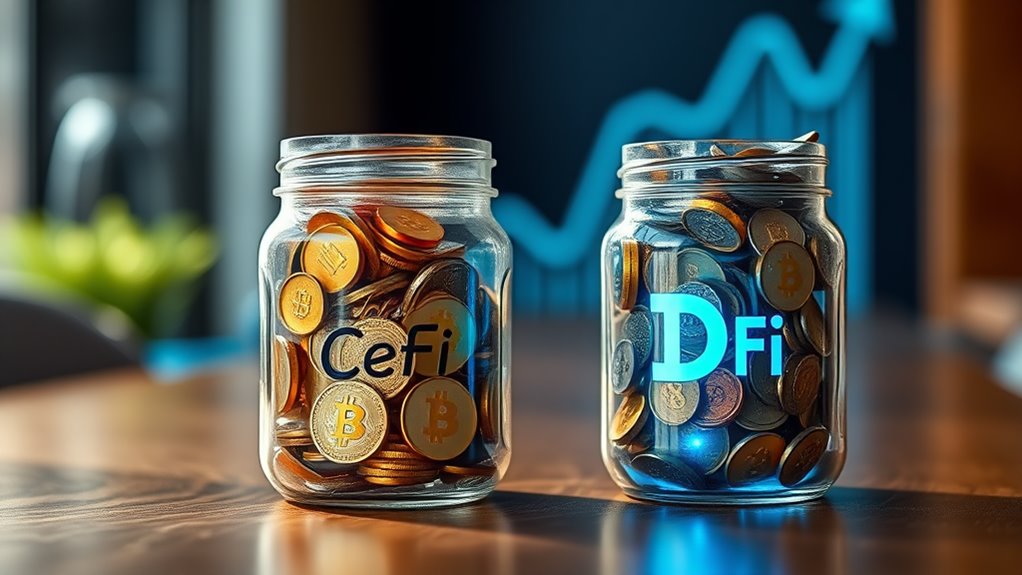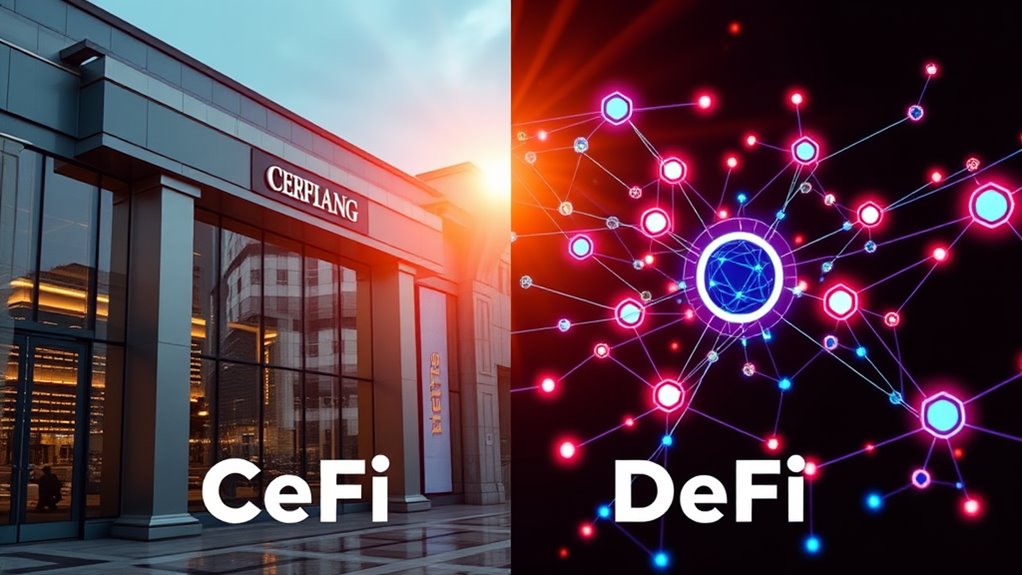
Cefi Vs Defi Lending: Which Offers Better Returns?
CeFi and DeFi lending models offer different financial returns. CeFi provides fixed interest rates, which offer predictability and stability. However, returns are generally lower due to operational costs. In contrast, DeFi features variable interest rates, influenced by market supply and demand, allowing for potentially higher yields. Nonetheless, these returns come with increased risks, such as market volatility and smart contract issues. Understanding these dynamics can help users make informed choices in their lending strategies. Further insights follow.
Key Takeaways
- CeFi typically offers stable, fixed interest rates, providing predictable returns for borrowers compared to variable rates in DeFi.
- DeFi can yield higher returns through dynamic interest rates influenced by market conditions, but with increased risk and volatility.
- CeFi platforms may offer yields on stablecoins as high as 16%, while DeFi returns can exceed 20% for certain cryptocurrencies.
- Market volatility significantly impacts DeFi returns, making them less stable than the predictable yields often found in CeFi lending.
- Diversifying across both CeFi and DeFi can optimize returns while managing associated risks effectively.
Understanding CeFi Lending Models

Understanding CeFi lending models is essential for individuals exploring the intersection of traditional finance and cryptocurrency. Centralized finance, or CeFi, involves platforms that manage lending through specific entities, blending traditional financial services with cryptocurrency benefits.
These platforms typically comply with regulatory standards, including Know Your Customer (KYC) requirements, enhancing security and trust. CeFi lending models usually feature fixed interest rates, providing borrowers with predictable costs.
Additionally, user-friendly interfaces simplify the borrowing process by eliminating the need for direct interaction with complex smart contracts. By integrating traditional financial systems, CeFi platforms often offer greater liquidity, allowing users easier access to funds. Furthermore, CeFi lending can provide competitive interest rates compared to traditional loans, making it an appealing option for borrowers.
Exploring DeFi Lending Mechanisms

In exploring DeFi lending mechanisms, several key components come into play, including yield farming strategies and liquidity pool dynamics.
Yield farming allows users to earn rewards by providing liquidity to decentralized platforms, while liquidity pools facilitate borrowing and lending through the aggregation of funds from multiple users. However, participants must also be aware of smart contract risks, as vulnerabilities in these self-executing agreements can lead to significant financial losses. Additionally, DeFi lending offers higher returns compared to traditional savings options, thanks to dynamic interest rates influenced by supply and demand.
Yield Farming Strategies
Yield farming strategies play an essential role in the decentralized finance (DeFi) ecosystem, enabling users to maximize their returns on cryptocurrency holdings.
These strategies often involve liquidity mining, where participants earn rewards by providing liquidity to various protocols. Users can also optimize their yields by diversifying across different platforms, utilizing tools that analyze market trends and risks.
Additionally, yield farming may include compounding returns through multiple lending and staking layers, enhancing potential earnings. Automated services like Yearn.finance streamline this process, reallocating funds to the most profitable opportunities. Furthermore, integrating liquid staking can provide unlocked liquidity, allowing users to earn staking rewards while still accessing their assets.
However, while the rewards can be significant, participants must consider the associated risks, especially in volatile markets, ensuring informed decision-making in their yield farming endeavors.
Liquidity Pool Dynamics
Liquidity pools serve as foundational elements within decentralized finance (DeFi) lending mechanisms, allowing users to contribute digital assets to smart contracts that facilitate various financial activities. These pools enable trading, lending, and other services without relying on centralized intermediaries. Users earn returns through transaction fees or interest, making participation attractive. Additionally, liquidity pools enhance the overall efficiency of the DeFi ecosystem by providing market liquidity, which is essential for reducing slippage.
| Feature | Description |
|---|---|
| Market Liquidity | Provides essential liquidity, reducing slippage. |
| Accessibility | Open to anyone, promoting financial inclusivity. |
| Automated Process | Smart contracts manage lending terms and conditions. |
Smart Contract Risks
Smart contracts, which automate transactions and enforce agreements in decentralized finance (DeFi) lending, come with significant risks that users must understand.
These risks can lead to substantial financial loss if not properly managed.
- Urgency and Security Concerns: Quick deployment can introduce bugs and vulnerabilities.
- Immutable Nature: Errors in smart contracts are hard to correct once deployed.
- Public Transaction Visibility: High-value contracts are prone to exploitation.
- Risk of Inaccurate Documentation: Poorly documented contracts can lead to user mistakes.
- Decentralization and Control: Governance may become unclear, risking mismanagement.
Understanding these risks is essential for users to navigate the evolving landscape of DeFi lending effectively and make informed decisions regarding their investments. Additionally, the inherent risks of crypto lending must also be considered when evaluating potential returns.
Comparing Interest Rates and Yields

Interest rates and yields play a crucial role in the decision-making process for individuals considering lending options in both Centralized Finance (CeFi) and Decentralized Finance (DeFi).
CeFi platforms typically offer fixed interest rates, providing stability, while DeFi platforms usually feature variable rates influenced by supply and demand. In CeFi, higher interest rates can be found for cryptocurrencies like DOT or AVAX, with rates reaching up to 20%.
Both platforms offer competitive yields on stablecoins, but CeFi platforms, such as Nexo, can provide rates as high as 16%.
Additionally, CeFi platforms often manage profits through established financial systems, whereas DeFi relies on automated smart contracts for distribution, reflecting different approaches to yield generation in these financial ecosystems. This variance highlights the importance of understanding APY in crypto staking as a measure of potential returns when comparing these lending options.
Evaluating Risk and Market Volatility

When evaluating risk and market volatility in lending platforms, it becomes essential to contemplate the differences between Centralized Finance (CeFi) and Decentralized Finance (DeFi).
CeFi typically offers more regulatory protection, while DeFi operates with greater market volatility and fewer safeguards.
Key risks include:
- Regulatory Risk: Unregulated environments increase legal uncertainties.
- Smart Contract Risks: Potential bugs in contracts may lead to losses.
- Self-Custody Risks: Users risk losing assets if private keys are misplaced.
- Liquidity Risks: Community-driven liquidity can fluctuate unexpectedly.
- Market Volatility: Price swings can drastically affect collateral values. Additionally, maintaining a good loan-to-value (LTV) ratio is crucial in mitigating liquidation risks during market downturns.
Understanding these factors is vital for users to make informed decisions about their investments in either lending platform.
Analyzing User Experience and Accessibility

User experience and accessibility play important roles in determining the attractiveness of lending platforms, especially when comparing Centralized Finance (CeFi) and Decentralized Finance (DeFi).
CeFi platforms typically offer user-friendly interfaces that resemble traditional financial services, making them more accessible for beginners. In contrast, DeFi platforms often require users to possess technical knowledge, as interaction with smart contracts and blockchain technology can be complex.
Customer support in CeFi is robust, enhancing user experience, while DeFi relies on community-driven support, which can vary in quality. Additionally, CeFi allows fiat transactions, broadening accessibility, whereas DeFi primarily caters to cryptocurrency users, limiting participation for those without digital assets. Furthermore, the choice between custodial and non-custodial lending models can significantly impact user experience and security preferences.
Assessing Long-Term Financial Returns

Evaluating long-term financial returns in lending platforms requires careful consideration of the differences between Centralized Finance (CeFi) and Decentralized Finance (DeFi).
CeFi typically offers stable but lower yields due to operational costs, while DeFi can provide higher returns through variable interest rates influenced by supply and demand. However, DeFi’s volatility can affect returns considerably.
Key considerations include:
- Variable APYs in DeFi: High potential returns but with risks.
- Stable yields in CeFi: Often more predictable.
- Security and regulatory compliance: CeFi may offer more robust measures.
- Market volatility impact: More pronounced in DeFi.
- Control over assets: Lenders maintain full control in DeFi environments.
Additionally, using cryptocurrency as collateral in lending can enhance liquidity without necessitating asset liquidation, potentially leading to avoiding capital gains taxes. Understanding these factors can guide investors in choosing the right platform for their financial goals.
Frequently Asked Questions
How Do Regulatory Changes Impact Cefi and Defi Lending?
Regulatory changes greatly impact both CeFi and DeFi lending. CeFi benefits from established frameworks ensuring compliance and consumer protection, while DeFi faces challenges due to decentralized operations, requiring specialized regulations to manage emerging risks effectively.
What Are the Tax Implications of Cefi and Defi Lending?
Tax implications for both CeFi and DeFi lending involve interest income taxation, capital gains on profits, and stringent reporting requirements. While CeFi simplifies compliance, DeFi’s rewards can trigger taxable events, complicating the landscape for investors.
Can I Switch Between Cefi and Defi Lending Platforms Easily?
Switching between CeFi and DeFi lending platforms can vary in ease. CeFi offers user-friendly interfaces, while DeFi requires technical knowledge. Users must consider regulatory implications, liquidity sources, and market conditions for a successful shift.
How Does Liquidity Affect My Returns in Cefi and Defi?
In the garden of finance, liquidity acts as sunlight, nurturing growth. In CeFi, it provides stable blooms, while DeFi’s wildflowers may flourish or wither unpredictably, affecting returns through the balance of market forces and participant engagement.
What Are the Future Trends in Cefi and Defi Lending?
Future trends in lending reveal CeFi’s potential adoption of blockchain, enhanced security, and regulatory compliance, while DeFi may focus on regulatory clarity, insurance protocols, and cross-chain expansion, fostering deeper institutional involvement and improved scalability.
Conclusion
To sum up, both CeFi and DeFi lending offer unique advantages and challenges that appeal to different types of investors. While some may argue that CeFi is safer due to centralized oversight, DeFi provides opportunities for higher returns and greater autonomy. Ultimately, the choice between them depends on individual risk tolerance and investment goals. By understanding the mechanisms and potential returns of each model, investors can make informed decisions that align with their financial strategies.












